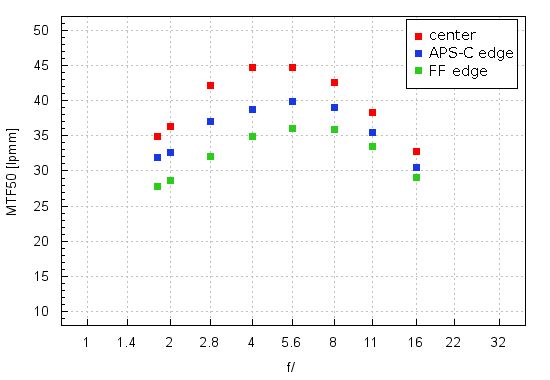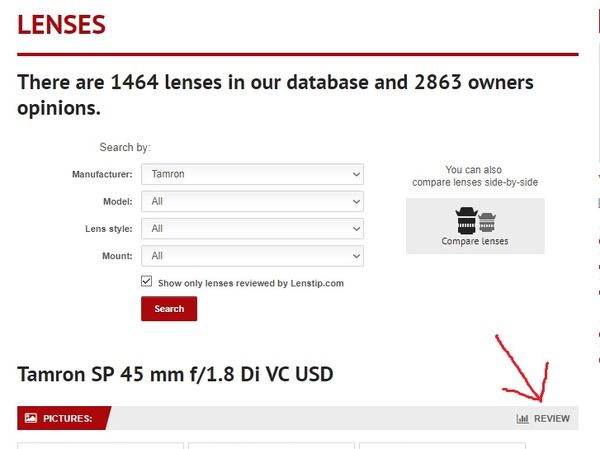wide angle prime lens
Oct 19, 2017 13:24:57 #
I am very new at manual photography. I understand that a large aperture number/smaller aperture opening will bring more of the entire photo in focus. Why will a wide angle prime lens f/2.8 not sacrifice sharpness for my landscape shots. Obviously I am not understanding something about prime lenses. And it must be very basic, because I cannot find the answer anywhere. I guess it comes down to the question," Can I vary or stop down the aperture of a prime lens? I would appreciate an explanation regarding these prime lenses. Thanks Maren
Oct 19, 2017 13:31:56 #
67skylark27
Loc: Fort Atkinson, WI
Prime lens aperture will function the same as any other lens. Prime lenses are fixed length only- not zoom.
Just think prime and fixed as being the same. Prime lenses typically are f1.4,1.8,2.0 or 2.8 for their max
aperture size, they can be stopped down just like any other lens for f8,f11,f13 etc.
The larger aperture of prime lenses allow for more and excellent blurring of the background which
is very difficult to achieve with a zoom lens of f6.3.
Just think prime and fixed as being the same. Prime lenses typically are f1.4,1.8,2.0 or 2.8 for their max
aperture size, they can be stopped down just like any other lens for f8,f11,f13 etc.
The larger aperture of prime lenses allow for more and excellent blurring of the background which
is very difficult to achieve with a zoom lens of f6.3.
Oct 19, 2017 13:32:01 #
maren wrote:
I am very new at manual photography. I understand ... (show quote)
Yes you can stop them down.
Oct 19, 2017 13:36:19 #
maren wrote:
I am very new at manual photography. I understand ... (show quote)
Yes, you can "stop it down." Many lenses, prime or otherwise, are sharper if stopped down a stop or two from wide open to a smaller aperture. This will, of course, require a slower shutter speed for a longer exposure. If you're shooting landscape on a day with no breeze (and using a tripod) the slower shutter speed will not hurt the quality of your images. Many of the iconic "calendar" type landscape shots are made at the crack of dawn before the wind starts blowing, using view cameras that can stop down to f/64. Everything is in focus, as you might imagine at f/64, and there's no subject movement to blur the image.
Oct 19, 2017 14:01:04 #
[quote=maren]I am very new at manual photography. I understand that a large aperture number/smaller aperture opening will bring more of the entire photo in focus. Why will a wide angle prime lens f/2.8 not sacrifice sharpness for my landscape shots. Obviously I am not understanding something about prime lenses. And it must be very basic, because I cannot find the answer anywhere. I guess it comes down to the question," Can I vary or stop down the aperture of a prime lens? I would appreciate an explanation regarding these prime lenses. Thanks Maren[/quot
Smaller the hole, sharper the image. Clench your first and make a small hole through your close tighten hand, make a small hole and look in to it at text, the text will be clear and sharp. Open your hand up a little and do the same exercise, the sharpness will degrade. Same as glass
Smaller the hole, sharper the image. Clench your first and make a small hole through your close tighten hand, make a small hole and look in to it at text, the text will be clear and sharp. Open your hand up a little and do the same exercise, the sharpness will degrade. Same as glass
Oct 19, 2017 14:10:44 #
Thanks for your time and knowledge skylark, Richard, Jackh, Marty. I can now move forward and look for a wide angle lens I have been wanting to purchase. maren
Oct 19, 2017 16:41:16 #
UHH members have given great explanations. Here is a chart that illustrates the image resolution of a prime lens that I have. It's the Tamron 45mm f/1.8. The horizontal scale are f-stops. The vertical scale is line pairs per millimeter. This lens has its best resolution at f/4 to f/5.6 where it can resolve about 45 line pairs per millimeter at the lens center. I've taken test shots at the different apertures they tested here. I can see a correlation. It's not sharp wide open at f/1.8. I try to stop down to at least f/2.8.
Oct 20, 2017 00:34:16 #
CO wrote:
UHH members have given great explanations. Here is... (show quote)
I have never seen anything like that graph. I love numbers and graphs. I have that same lens and I love it--even on my D500. Thanks CO for that information. Maren
Oct 20, 2017 05:53:06 #
maren wrote:
I have never seen anything like that graph. I love numbers and graphs. I have that same lens and I love it--even on my D500. Thanks CO for that information. Maren
I got the chart from LensTip.com. They usually test lenses in eleven or sometimes twelve categories. After you've selected your lens from the pop down boxes you'll have to click on "REVIEW" on the right end of the gray bar. I did a screen shot with a red arrow pointing to it. Once you're in the review, scroll down to the bottom of the page and click on the different categories.
Oct 20, 2017 07:42:09 #
maren wrote:
I am very new at manual photography. I understand ... (show quote)
Yes, just like squinting, using a smaller aperture will usually give you better sharpness and depth of field. Of course, a lot depends on the actual lens. Prime or zoom work the same where aperture is concerned, so you can vary the aperture as you see fit. I prefer zoom lenses because I can get the composition I want. "Zooming with your feet" is often not possible.
Oct 20, 2017 08:17:57 #
Since nobody seems to have mentioned this, I will point out that DOF relates to three variables - aperture (smaller = more DOF), focal length (shorter focal length = more DOF) and imaging area or format (smaller film or chip size = more DOF).
So, at a given aperture on a given camera format, a 20MM lens will give more DOF than a normal or telephoto.
So, at a given aperture on a given camera format, a 20MM lens will give more DOF than a normal or telephoto.
Oct 20, 2017 09:22:49 #
Oct 20, 2017 09:30:02 #
maren wrote:
I am very new at manual photography. I understand ... (show quote)
A prime lens is a lens that has a single focal length. A zoom lens changes focal lengths, but is usually not as sharp as a prime which is optimized for a single focal length. The very best lens for landscapes IS a wide angle prime, which you can stop down the aperture as much as you like. Shoot it at 2.8 and the foreground will probably be soft, but at 11 you will be sharp from near to infinity.
Oct 20, 2017 10:19:31 #
You do not seem to have enough information on basic photography. It is impossible to become a competent photographer without that basic knowledge.
ALL lenses have apertures, also called lens openings. Modern lenses work communicating with the electronics of the camera and the apertures are usually manipulated with controls in camera. Even lenses that only work manually, like old lenses, they have aperture values in the barrel that allow the photographer to select the aperture needed for the job at hand.
Modern prime lenses or zooms both work the same way, apertures are controlled electronically in the camera. The same goes, in case you need to know, with the shutter speeds. I am sure you know that in the manual mode both parameters need adjustments by the photographer when taking the exposure.
If landscapes is what you want to shoot in general a small aperture (large number) works best because of the depth of field and that means how much is in focus and the general rule is 1/3 in front of the focused area and 2/3 behind. Wide apertures are used for what is called "selective focus" meaning that the focus area will be sharp while the rest will be blurred, a technique often used to shoot head and shoulder portraits.
I hope this helps you to understand some basic concepts.
ALL lenses have apertures, also called lens openings. Modern lenses work communicating with the electronics of the camera and the apertures are usually manipulated with controls in camera. Even lenses that only work manually, like old lenses, they have aperture values in the barrel that allow the photographer to select the aperture needed for the job at hand.
Modern prime lenses or zooms both work the same way, apertures are controlled electronically in the camera. The same goes, in case you need to know, with the shutter speeds. I am sure you know that in the manual mode both parameters need adjustments by the photographer when taking the exposure.
If landscapes is what you want to shoot in general a small aperture (large number) works best because of the depth of field and that means how much is in focus and the general rule is 1/3 in front of the focused area and 2/3 behind. Wide apertures are used for what is called "selective focus" meaning that the focus area will be sharp while the rest will be blurred, a technique often used to shoot head and shoulder portraits.
I hope this helps you to understand some basic concepts.
Oct 20, 2017 11:22:29 #
amfoto1
Loc: San Jose, Calif. USA
f8lee wrote:
I will point out that DOF relates to three variables...
I will point out that DOF relates to three variables...
Yes there are three variable effecting Depth of Field.
f8lee wrote:
...aperture (smaller = more DOF)...
Yes aperture size (f-stop) is one of those variables and has direct effect on DoF.
f8lee wrote:
...focal length (shorter focal length = more DOF)
Yes lens focal length also has direct effect on DoF.
f8lee wrote:
...and imaging area or format (smaller film or chip size = more DOF).
NO! This is incorrect. Sensor size has NO direct effect on Depth of Field.
The third variable effecting DoF is distance from the camera to the object. The closer you are to an object with any given focal length and aperture, the shallower the Depth of Field will be around that object.
The reason sensor size seems as if it has effect on DoF is because whenever you change sensor size, in order to compose an image of a subject the same way you also will need to change either the distance to your subject or the focal length of your lens.... or some of both.
If you want to reply, then register here. Registration is free and your account is created instantly, so you can post right away.









